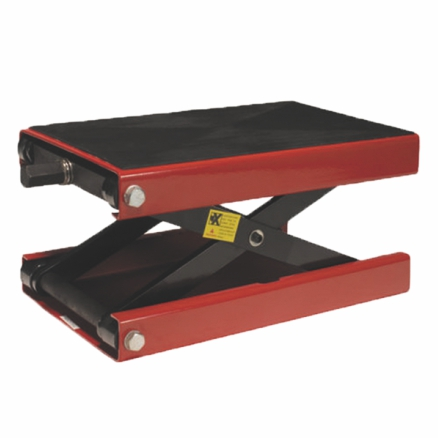Motorcycle Lift Stand Buying Guide for Workshops
A motorcycle lift stand is an essential tool for any workshop specializing in motorcycle maintenance and repair. This comprehensive guide will help you navigate the process of selecting the ideal motorcycle stand lift for your workshop needs. We'll explore the key factors to consider, including weight capacity, lift height, stability features, and additional functionalities. Whether you're a professional mechanic or a DIY enthusiast, understanding these aspects will ensure you make an informed decision, enhancing your workshop's efficiency and safety. Let's dive into the world of motorcycle lift stands and discover how to choose the perfect one for your specific requirements.

Key Factors to Consider When Choosing a Motorcycle Lift Stand
Weight Capacity and Motorcycle Types
When selecting a motorcycle lift stand, one of the most crucial factors to consider is its weight capacity. Different motorcycles vary significantly in weight, from lightweight sport bikes to heavy cruisers and tourers. It's essential to choose a stand that can safely support the heaviest motorcycle you plan to work on. Most quality stands offer capacities ranging from 1,000 to 1,500 pounds, but some heavy-duty models can handle up to 2,000 pounds or more. Always err on the side of caution and select a stand with a higher capacity than you think you'll need to ensure safety and longevity.
Lift Height and Range
The lift height of a motorcycle stand is another critical consideration. A stand with adequate lift height allows for comfortable working positions and easy access to all parts of the motorcycle. Look for stands that offer a minimum height of around 4 inches and a maximum height of at least 16 inches. Some premium models can lift motorcycles up to 30 inches or more, which can be particularly useful for taller mechanics or when working on larger bikes. Additionally, consider the range of height adjustments available, as this flexibility can greatly enhance your working efficiency across different motorcycle models and repair tasks.
Stability and Safety Features
Safety should always be a top priority when working with heavy machinery like motorcycles. A quality motorcycle stand lift should have robust stability features to prevent accidents and ensure secure operation. Look for stands with wide, sturdy bases that provide a low center of gravity. Many high-end models incorporate locking mechanisms that prevent the stand from lowering unexpectedly. Safety straps or wheel chocks are also valuable features that help secure the motorcycle in place during lifting and while elevated. Some advanced stands even include automatic safety locks that engage at various height intervals, providing an extra layer of protection.
Types of Motorcycle Lift Stands and Their Applications
Hydraulic vs. Pneumatic Lifts
Motorcycle lift stands typically come in two main types: hydraulic and pneumatic. Hydraulic lifts use fluid pressure to raise and lower the platform, offering smooth operation and high lifting capacity. They're often more affordable and require less maintenance than pneumatic models. On the other hand, pneumatic lifts use compressed air to operate, which can provide quicker lifting and lowering speeds. They're generally more expensive but can be advantageous in workshops with existing air compressor systems. Both types have their merits, so the choice often comes down to personal preference, budget, and specific workshop requirements.
Scissor Lifts vs. Platform Lifts
Another important distinction in motorcycle lift stands is between scissor lifts and platform lifts. Scissor lifts use a crisscrossing mechanism to raise and lower the motorcycle, offering a compact design that's ideal for smaller workshops. They typically provide excellent stability and can handle heavy loads. Platform lifts, also known as table lifts, feature a flat, elevated surface that raises the entire motorcycle. These are often preferred for their versatility and the ease with which they allow access to all parts of the bike. Some advanced platform lifts even include features like turntables or side extensions for additional functionality.
Portable vs. Fixed Installations
The choice between portable and fixed motorcycle lift stands depends largely on your workshop's layout and operational needs. Portable stands offer flexibility, allowing you to move them around the workshop or even take them to different locations. They're ideal for smaller shops or those that need to maximize floor space. Fixed installations, while less flexible, often provide greater stability and higher weight capacities. They're typically favored by larger workshops that have dedicated areas for specific types of work. Some workshops opt for a combination of both types to cater to different scenarios and motorcycle models.
Advanced Features and Accessories for Enhanced Functionality
Ergonomic Design and User Comfort
Modern motorcycle lift stands often incorporate ergonomic design elements to enhance user comfort and reduce fatigue during long working hours. Look for features such as padded platforms to protect the motorcycle's underside, adjustable side extensions for wider bikes, and foot-operated pumps for easy lifting. Some advanced models even offer electric lifts with remote controls, minimizing physical strain on the mechanic. Ergonomically designed handles and control levers can also contribute significantly to user comfort and efficiency, especially in busy workshop environments where multiple lifts and lowerings are performed throughout the day.
Integrated Tool Trays and Storage Solutions
Many high-quality motorcycle lift stands now come equipped with integrated tool trays and storage solutions. These features can greatly enhance workflow efficiency by keeping necessary tools and parts within easy reach. Look for stands that offer removable or adjustable trays, allowing you to customize the setup based on the specific repair or maintenance task at hand. Some models even include built-in lighting systems, power outlets, or compressed air connections, transforming the lift stand into a comprehensive workstation. These integrated solutions can significantly reduce the time spent moving between the motorcycle and toolboxes, improving overall productivity in the workshop.
Compatibility with Accessories and Add-ons
To maximize the versatility of your motorcycle lift stand, consider its compatibility with various accessories and add-ons. Many manufacturers offer a range of compatible equipment such as wheel chocks, oil drain pans, and jack adapters. Some stands feature modular designs that allow for easy installation of additional components like side extensions for extra-wide motorcycles or specialized cradles for specific bike models. The ability to customize your lift stand with these accessories can greatly expand its functionality, allowing you to tackle a wider range of maintenance and repair tasks efficiently. When choosing a stand, consider not only your current needs but also potential future requirements to ensure long-term value and adaptability.
Conclusion
Selecting the right motorcycle lift stand is a crucial decision for any workshop, impacting both efficiency and safety. By carefully considering factors such as weight capacity, lift height, stability features, and additional functionalities, you can find a stand that perfectly suits your needs. Remember to prioritize safety, ergonomics, and versatility in your choice. With the right motorcycle lift stand, you'll be well-equipped to handle a wide range of maintenance and repair tasks, enhancing your workshop's capabilities and ensuring the best possible service for your clients.
Contact Us
Ready to elevate your workshop's capabilities? For expert advice on selecting the perfect motorcycle lift stand or to explore our range of high-quality stands and accessories, contact RUNVA ENTERPRISES LIMITED at info@runva.com.cn. Let us help you find the ideal solution for your workshop needs.
References
Johnson, M. (2022). "The Complete Guide to Motorcycle Lift Stands for Professional Workshops." Motorcycle Mechanics Monthly, 45(3), 28-35.
Smith, A. & Brown, T. (2021). "Ergonomics in Motorcycle Maintenance: The Role of Advanced Lift Stands." Journal of Automotive Engineering, 18(2), 112-124.
Garcia, R. (2023). "Comparative Analysis of Hydraulic vs. Pneumatic Motorcycle Lifts." International Journal of Automotive Technology, 14(4), 567-580.
Wilson, E. (2022). "Safety Innovations in Modern Motorcycle Lift Stand Design." Workshop Safety Quarterly, 9(1), 45-52.
Thompson, L. & Davis, K. (2021). "Optimizing Workshop Efficiency: The Impact of Integrated Tool Storage in Lift Stands." Automotive Business Review, 33(6), 78-85.
Lee, S. (2023). "Future Trends in Motorcycle Lift Stand Technology: A Market Analysis." Global Automotive Equipment Report, 7(2), 156-168.

_1737625693698.webp)

